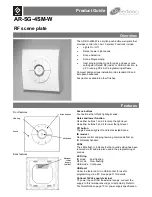
Page 15/37
Operating Instructions
BA 373-E66
Technical specifications subject to change
W. Bälz & Sohn GmbH & Co.
Koepffstrasse 5
74076 Heilbronn
Germany
Phone +49 (0)7131 15 00 0
Fax +49 (0)7131 15 00 21
www.baelz.de
Observe copyright protection DIN 34
It is operated by the axial motion of the connecting rod via the adjusting lever
[260]
with continuously adjustable
slider
[261]
which is fitted to the threaded bolt of the connecting rod. The slider engages in the slot of the driv-
ing lever
[259]
. The axial motion is converted into a rotary motion which is transferred to a gear wheel which then
operates the potentiometer and the cam shaft for WE switches S3 and S4.
Figure 10: Position of the switching and signalling unit in the actuator
If the linear actuator (actuator with yoke mounted on the valve) is supplied with integrated switching and signalling
unit with WE switches S3 and S4
[282]
and/or potentiometer, the slider
[261]
in the adjusting lever
[260]
is
adjusted to the travel specified in the order.
To avoid any risk of damage, actuators with yoke not mounted to the valve, do not have the adjusting lever
[260]
mounted to the threaded bolt of the connecting rod. The adjusting lever
[260]
with slider
[261]
, the Baelz anti-rota-
tion fixture, self-locking nuts
[287]
and Teflon washers
[290]
are supplied separately with the actuator.
6.2 Mounting and setting the switching and signalling unit
After the linear actuator has been assembled on the valve as described in chapter 4.2, install the separately sup-
plied or previously removed adjusting lever (see figures 8, 9 and 10):
● Use the handwheel to move the actuator to the end position "connecting rod extended" until DE switch S1
switches (check with a measuring instrument, if necessary)
● Screw a self-locking nut
[287]
onto the threaded bolt of the connecting rod
● Place a Teflon washer
[290]
onto the nut
● Rotate the camshaft so that the driving lever
[259]
points up
● Hang the adjusting lever
[260]
with slider
[261]
into the slot of the driving lever
● Position the adjusting lever
[260]
so as to be above the threaded bolt of the connecting rod
● Rotate the camshaft back to its original position and place the adjusting lever onto the threaded bolt
● Fit the Baelz anti-rotation fixture
● Place the second Teflon washer
[290]
onto the threaded bolt
● Screw the second self-locking nut
[287]
onto the threaded bolt
● Turn the two hex nuts
[287]
to adjust the adjusting lever
[260]
on the threaded bolt of the connecting rod
such that adjusting lever
[260]
and driving lever
[259]
are exactly in parallel in their tilted position
● Tighten adjusting lever
[260]
with nuts
[287]
and ensure parallel alignment of the two levers when viewed
from the top
When tightening the upper nut
[287]
with an open-end wrench with width across flats 10, hold the lower nut
[287]
to prevent deformation of the threaded bolt.















































